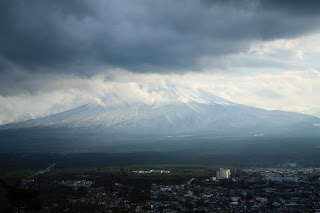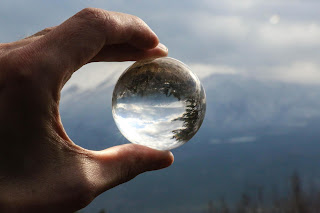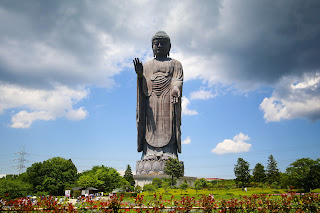Hello fine people! A busy last few days it has been, with my friend Perry visiting from Wellington for a week, I've been doing a bit of touring around and showcasing Tokyo and the surrounding region, which has given me an excuse to look at some places I haven't yet had the chance to!
Perry had indicated he wanted to get outside of the city and do some outdoorsy things, so I thought a trip to Kawaguchiko would be in order. This is the town that is at the base of Mt Fuji in Yamanashi Prefecture, and is a popular launching spot for climbing expeditions up the mountain. Being only the start of spring, the mountain is still covered in snow and is off limits (being 3776m high I would not want to be up there at the moment). However Kawaguchiko affords some good views of the mountain, as well as being full of places for adventure. We took a bus from Shinjuku early in the morning, going for an hour and a bit, watching the skyscrapers become urban sprawl, urban spral become rural villages, and finally rural villages become mountains. It was a clear and crisp day as we arrived with snow on the ground in places, and after a quick stop at the information centre, we went, bus pass in hand, off on the first step of our day trip.
 |
| Mt Fuji is still very snowy, and as such very much off limits to climbing - check back in 3 months! |
Narusawa Icecave is a site I have heard about plenty of times before, and have long wanted to visit. The caves are formed by lava from ancient eruptions, and crisscross the land around Mt Fuji. Looking at the forest floor we could see evidence of this, with many sink holes and cracks in the ground that led into caverns and underground passageways. Two of these caves in particular are well known for having year round ice features, being deep and cold enough to act as refrigerators of sorts. Such an otherworldly feature was definitely on my go to list.
 |
| Credit to Perry |
Donning helmets we walked down a short path to the first cave, which opened out into a large and shallow opening, steps hewn into the rock and supported by bamboo bannisters. Following the lights that had been conveniently set up for us, we ducked, crawled and scrambled forward, through passages that were less than a metre high - a good thigh workout I tell you! Before long evidence of the icy nature of the place became apparent, with small icicles formed on the ceiling, and patches of slippery white on the walls and floor. The cave has been well developed over time for visitors, with non slip mats and bannisters on the actual path, but you are constantly surrounded by icy, volcanic rock, as well as the quintessentially cavey drip drip sound closer to the entrance.



In the main chamber, huge iceblocks had been arranged into place; apparently these caves were historically used as food, seed, and silkworm storage, and so having some structure to the cooling enabled effective storage systems to be in place. Smaller, inaccessible passages led from the main chamber, many of which were barred by spikey icicles, and blue and white light illuminated everything in a very eerie way. It was fairly challenging photographically speaking, both because of the space available to us but also because of the low light situation. There were also a few very small shrines inside the caves, resting on huge beds of ice with icicles all around them.












The second cave, known as the Wind Cave, is much the same, only that it is a bit more open so less crawling was required, instead only a constant awareness of lower than normal ceiling height (fortunately no heads were donked). This one was a historical seed and silkworm storage cave, much like the doomsday vault in Svalbard for seeds. Edo Era Japanese discovered that silkworms and their cocoons responded to temperature changes as consistent with the beginning of spring, so if they kept large numbers chilled, they could then thaw them out at an opportune time for harvesting the fibres, Apparently this enabled the Japanese to have four to fiver harvests a year, rather than the normal two, so a very good development for them! The cave was also used as seed storage, preventing the surplus fro germinating, and also enabling the seeds that require "curing" in the cold first to properly take off to do so.
After we returned to the surface, it was a walk along to the forest tracks to the bus stop. The forest on the north west part of Fuji where we were, is called Aokigahara, and is known as the sea of trees. It was easy to see why as from the path the forest very quickly became a wall of green, not something one would want to get lost in! As mentioned above, the forest floor is heavily bored with caverns and holes, making it a precarious place to traverse off track. The Japanese Self Defence Force uses the forest for training in navigation and woodland exercises, and it also has a rich history of ghosts and spirits. Unfortunately the forest is also a popular suicide location, with many of the carparks having abandoned cars, and anti-suicide messages are on the tracks at points. Fortunately we were on the fringe of the forest, and those who go there to do that are inclined to go in deeper (March-April is apparently the worst time of year for suicides, being the end of the financial year), so we were spared any evidence of such, though there was a slight eeriness to the place as we knew what it was so famous for.
 |
| The sea of trees is an apt name |
Taking a bus from the edge of the forest back into town, after a quick bite to eat it was along to the other side of the lake to take a gondola up part of one of the mountains surrounding Mount Fuji. Mt Tenjo translates to "above heaven", and while it is "only" about 1100 metres high, a third of Fuji; it did give us a good view of the place. Taking the gondola up as far as we could, we then hiked the track to the summit, which was a very simple affair in a small wooded clearing. Unfortunately by this time the clouds were setting in some, and so the entirety of the mountain was partially obsscured, but we were still definitely able to appreciate the scale of the thing - it is truly huge (even when not right in front of it). Opting to hike down the mountain rather than gondola down,unlike many of the other tourists (read: all of the other tourists - we did not come across a single person going up or down the track as we made our descent - not surprising given how many tourists we saw wearing either high heels, stark white shoes (the summit was very muddy so who knows how well that went for them), or in a few cases, sheepskin ugg boots - there was a little bit of barely suppressed derision from Perry and I in that respect. The walk down was covered in hydrangea plants, so in summer I can imagine the entire slope being all shades of blues and purples, making it something to consider braving the oppressive Japanese summer for.







The place also had some curious mascots going on, characters from some folk story around the area and the mountain
Finally at the base of the mountain, it was a short wait for a train, which took us to Arakura Sengen Pagoda, which graces the covers of many Japanese guidebooks, combining as it does the traditional architecture of the pagoda with a contemporary Japanese city (plus rollercoaster park), and the iconic Mt Fuji. Unfortunately for us by now Fuji was well clouded over, and sunset was rapidly approaching, so the quintessential shot evaded us (I'll just have to go back), but the pagoda itself was very pretty even in the low light. The time before our last train back to the main station, from where our coach would take us back to Tokyo was rapidly approaching, so it was a quick descent down a very steep staircase, and before we knew it we were back at the tourist information centre for a dinner of ramen noodles, and then hopping on the bus for the trip back into the metropolis.






Arriving in Shinjuku, we decided to find a bar to have some Japanese sake, as Perry had never experienced that, for which we went to Golden Gai, the dive bar quarter of Shinjuku - dozens and dozens of tiny bars that often sit no more than 10 people, and is hugely popular with Japanese and foreigners alike. Our chosen bar was up a narrow and low staircase, with every drink 800 yen, and seated 8 people. We tried their sake (not bad), and had a couple of other drinks with a chatty Japanese (being the only foreigners in this bar we were slight novelties), and then we were very surprised when one guest pulled out a birthday cake and shouted everyone champagne - there will be a photo somewhere on instagram of Perry's and my hands and arms all geared up for hiking and caving, holding champagne glasses in a circle with a bunch of Japanese - a very pleasant surprise that!
The next day was a trip to the zoo! Ueno Zoo is Japan's oldest, and is famous for having Pandas - they originally had two, but managed to breed them to produce a cub a year or so ago, which led to the place being incredibly popular - this in a country which has huge crowds as is. It was at the point where you had to apply for tickets to see the pandas, but they've recently done away with that, so Perry and I decided to have a slightly more sedate day than the previous (though still involving lots of walking). The zoo, being a bit old in parts, had perhaps not the most modern or spacious of enclosures for some of their animals, which did have a few ethical concerns going on as a result, but in other parts it was reasonably well done for a zoo. It was also a very cheap experience (600 yen or about $7), so it was with quite low expectations we went in. The entire day was spent there, so we certainly got out money's worth, and saw some pandas which was cool, having never seen that before. Beyond that there's not much in the way of narrative to be had at the zoo, so the rest is more or less a photo spam (animal photography often requires a large volume of shots, with this being no exception - I took over 2000 there!)
 |
| The animal people would queue up for up to an hour to see - we got there in less than ten minutes |
 |
| Plum blossoms are in full bloom |
 |
| Philosopher gorilla |
 |
| A pensive Slow Loris munching on a carrot |
 |
| I think the Secretary Bird is my new favourite bird out there; that plumage! |
 |
| Impressive eyelashes! |
 |
| Feeding time? |
 |
| Bushbabies! |
 |
| A little Japanese Ratsnake poking its head out |
 |
| A lemur and a slightly undignified tortoise |
 |
| Playing "The Floor is Lava" perhaps? |
 |
| Couldn't help myself with this instance of "Engrish" |
I've had a few more adventures with Perry while he's been here, so there'll definitely be another blog coming in the near enough future - though I think I'm all mountained out for the immediate future! So until then, tata for now :)
Troy





























































































Comments
Post a Comment